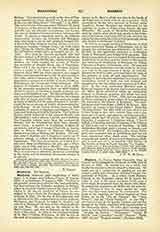

Marchesi, POMPEO, a Lombard sculptor of the neo-classic school, b. at Saltrio, near Milan, August 7, 1790; d. at Milan, February 6; 1858. He studied in Rome under Canova and received much encouragement from his master. The greater part of his life was spent in Milan, where for many years he was professor of sculpture at the Academy. He executed a great number of groups in marble and portrait busts. One of his earliest works was a colossal statue of St. Ambrose, patron of the city; for the Arco della Pace (Simplon commemorative arch), completed 1838, he made the reliefs of Terpsichore and Venus Urania. He decorated the facade of the Castello with twelve figures of great Italian captains, and that of the Palazzo Saporiti with reliefs in modern classic style. One of his best-known compositions is the group of the “Mater Dolorosa”, in the church of San Carlo, at which he labored many years. Works outside of Milan are the colossal statue of Charles Emmanuel III at Novara; that of Philibert Emanuel of Savoy at Turin; the sitting figure of Goethe for the library at Frankfort; two statues of the Emperor Francis I of Austria, one made with the assistance of Manfredoni, for Goritz, and another, unassisted, for the Hofburg at Vienna. He also executed the monument to Volta at Como; the monument of the singer Malibran; others to Beccaria and Bellini and a bust of Professor Zuccala for the Atheneum of Bergamo.
M. L. HANDLEY

